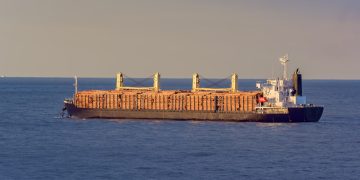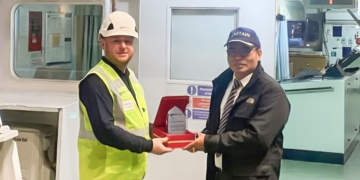According to MPA Singapore, more than 500 participants from the industry, academia and international organisations gathered at the Accelerating Digitalisation and Decarbonisation Conference to discuss how value-chain stakeholders can work together to produce, transport, and bunker net-zero fuels safely.
In his opening address, International Maritime Organization (IMO) Secretary-General Arsenio Dominguez highlighted the concrete steps taken by IMO Member States following the landmark adoption of the 2023 IMO Strategy on Reduction of GHG Emissions from Ships.
The IMO 2023 GHG Strategy demonstrates the shared commitment of Member States and the global shipping industry. We are on track to adopt mid-term measures by late 2025 to cut GHG emissions, to reach net zero targets.
…Dominguez said.
At the Marine Environment Protection Committee (MEPC 80) in July 2023, Singapore had worked actively with the IMO and other Member States to forge consensus in the adoption of the 2023 Strategy for the Reduction of GHG emissions from ships.
As explained, MPA and the International Energy Agency (IEA) signed an MoU on the Energy Transition of the Maritime and Port Industries and announced the partnership at the event. The MoU will enable the sharing of best practices across maritime and energy industries, support the adoption and transition of zero and near-zero emission fuels by these industries through capacity building training programmes, and contribute to relevant fuel-related projects and initiatives such as the IMO-Singapore NextGEN and NextGEN Connect Initiatives. This will support the development of the IEA Regional Cooperation Centre to be hosted by Singapore. IEA Chief Economist, Mr Tim Gould, shared that the IEA warmly welcomes this MoU as a major step forward in their cooperation with the MPA, a critical player in the region and the world, to improve access to low-emission fuels. 50 proposals for the supply of methanol as a bunker fuel in Singapore.
Following the completion of the world’s first ship-to-containership methanol bunkering in Singapore last year, MPA launched an expression of interest (EOI3) for the supply of methanol as a marine fuel in Singapore.
There was strong interest in the EOI. MPA received a total of 50 submissions, out of which 40% of them proposed end-to-end solutions covering all three areas highlighted in the EOI. Over 60 regional and international companies comprising energy companies, fuel suppliers, traders, bunker operators, and storage companies, participated in the EOI, signalling clear business confidence in Singapore as a key offtake location for methanol by international shipping.
Next steps for the development of ammonia bunkering capabilities
In March 2024, the world’s first ocean-going ammonia-powered vessel, Fortescue Green Pioneer, successfully conducted its first fuel trial in Singapore4 over a period of six weeks. The Fortescue Green Pioneer received flag approval from the Singapore Registry of Ships (SRS) and the ‘Gas Fuelled Ammonia’ notation by classification society DNV to use ammonia, in combination with diesel, as a marine fuel. A second tranche of three tonnes of liquid ammonia will be loaded for the Fortescue Green Pioneer to conduct further tests and trials over the next few weeks. As part of the line-up of events at Singapore Maritime Week 2024, Fortescue Green Pioneer will be berthed at Keppel Bay. IMO Secretary-General Arsenio Dominguez will be visiting the Fortescue Green Pioneer to meet maritime professionals onboard and learn more about the safety measures and emergency response procedures onboard the ammonia-fuelled vessel.
MPA and the Energy Market Authority (EMA) are currently reviewing proposals to develop an end-to-end solution to provide low- or zero-carbon ammonia for power generation and bunkering on Jurong Island. The proposals were submitted by the shortlisted consortiums from MPA and EMA’s EOI in a restricted Request for Proposal (RFP5). The bidders will be further shortlisted and MPA and EMA will work with the selected parties on the pre-Front End Engineering Design (pre-FEED) study for ammonia import terminals, ammonia bunkering and ammonia power generation. The pre-FEED is intended to confirm the technical and economic feasibility of the project before MPA and EMA select a lead developer for the project with the government by Q1 2025.
In line with the national target to achieve net-zero by 2050, MPA had announced domestic targets for port and terminal operators to reach net-zero by 2050, and for all new harbour craft to be fully electric, capable of using B100 biofuel or compatible with net-zero fuels from 2030 onwards. Pilots for bunker tankers, tugboats and pleasure craft are being considered and the timelines for these vessel types will be announced in due course.
The current operational berths at Tuas Port use electrified port equipment such as quay cranes, yard cranes, and Automated Guided Vehicles, which can reduce carbon emissions by about 50% compared to diesel prime movers. Port operator, PSA, will also further reduce energy consumption at Tuas Port through smart grid solutions, battery energy storage systems and optimisation of container handling processes. Tuas Port’s Maintenance Base building was constructed with intelligent energy management strategies and solar photovoltaic panels to harvest energy, making it one of Singapore’s first Super Low Energy Building, using 58% less energy compared to other similar sized buildings. PSA aims to achieve net zero emissions by 2050.































































